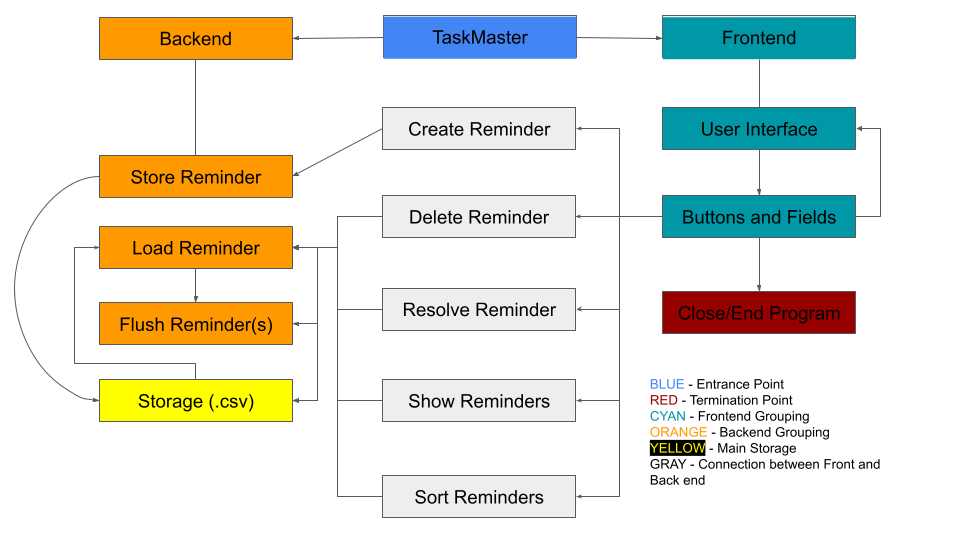amaa-team.github.io
Design Document

Architecture
-
The AMAA team has decided to use a repository-style architecture with slight features from the architectural style of layering. The team chose this architecture due to it’s simple way of showing how different methods can connect the frontend to the backend. Furthermore, it helps visulize the relationship from top to bottom of the software.
- When TaskMaster is first started, the user is greeted with the frontend, which contains all the buttons that they are allowed to press.
- At the same time, the backend access the storage for the project, a
.csvfile.
- At the same time, the backend access the storage for the project, a
-
Whenever a user presses a button (or enters text(s) to a field) (grey objects on the diagram), this directly calls a method and helps do what the user wants to do.
- In the backend,
Storage,Store Reminder, andLoad Reminder, work closely with one another; as both Store Reminder and Load Reminder depend on storage. ForFlush Reminders, this depends onLoad Reminder.
Major Classes and Object Responsibilites
- Currently there are three important classes:
TaskMaster_Main.java- The main job of this class is to setup the environment properly (loading the correct welcome screen, loading the correct application icon, .css file, etc.). Once all of the needed setup portions have been done, all control relinquishes to
Controller.java
- The main job of this class is to setup the environment properly (loading the correct welcome screen, loading the correct application icon, .css file, etc.). Once all of the needed setup portions have been done, all control relinquishes to
TaskMaster_Reminders.java- Working hand-in-hand with
Controller.java, this class has all the needed methods to store, load, and access reminders. It will also contain the methods for quotes. - This class is also responsible for checking and accessing the
.csvfile, where all the reminders are stored. - see “Object Responsibilities”
- Working hand-in-hand with
Controller.java- Once control has been relinquished from
TaskMaster_Main.java, the controller class contains methods for each button and text field the user may use/fill out. The class works directly with the.fxmlfiles found in the project folder.
- Once control has been relinquished from
- FXML Files
- All files with the
.fxmlextension contain the necessary data for the frontend, essentially. They contain what each button will do (using theController.javaclass) and which method said button will do.
- All files with the
- Object Responsibilities
- The
Controller.javaclass creates aTaskMaster_Remindersobject. The purpose of creating this object is for storage purposes. ThestoreReminders()method takes a list as a parameter. The creation of the object helps with this, as there is a global list that containsTaskMaster_Remindersobjects, which are then stored one-by-one in the .csv file.
- The